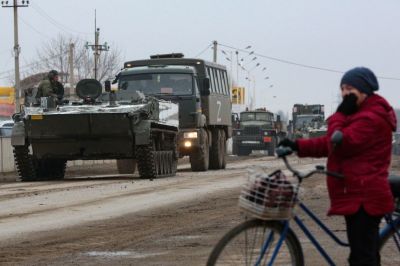Russia's many military failures explained

On a recent segment of “One Nation With Brian Kilmeade,” retired General and former CIA Director David Petraeus provided the following observations about the Russian military:
“They have failed to integrate their ground maneuver and their air assets, something we thought they would use to great effect. That's really the essence of blitzkrieg going all the way back to, say, 1939, and they haven't been able to achieve combined arms effects. In other words, using armor together with infantry, with engineers, with indirect fire, mortars, artillery, drones and all the rest of that, they just have not seen any of those kinds of operations, which again, we take for granted and are just the normal standard.”
Three weeks after the Russian invasion of Ukraine, Americans saw a great deal of the brutality of the war. We are all sickened by the images, and pray for the end to come. At this point, most understand that NATO supports Ukraine, but will not risk nuclear war by direct confrontation with the Russian military, including not supporting a “no-fly” zone. Most have seen things like the massive Russian convoy, stretching potentially 40 miles, coming from Belarus south to the outskirts of Kyiv. What’s not as clear from the network coverage are reasons the Russians have been held up by Ukrainian forces. From my own military experience, as well as information from various sources, I would like to offer the following explanation about Russian missteps beyond the logistics issues from my last article.
The critical problem with the Russian military appears to be a lack of training, both individual and collective. Most have seen the reports that Russian conscripts make up a substantial number of the invading forces and Russia has admitted the use of conscripts in Ukraine. In Russia, all male citizens aged 18-27 must serve for 12 months in the armed forces in what Russia calls “Universal Military Obligation.” These are the conscripts, and most will complete this required service at the ages of 18-20. For context, in the US military and in NATO nations, all service is voluntary but the length of service is at least 3-4 years for one enlistment. For many specialties, servicemembers train for just under a year to complete the basic and advanced individual training. Then new military members train with their unit to become truly proficient. With only 12 months of service, Russian conscripts would have been woefully undertrained for major combat operations compared to US and NATO troops, and morale would suffer.
As General Petraeus made clear, Russians have shown an utter failure of combined arms effects. Russian collective training appears to have been woefully inadequate. Units, which are made up of recruits and longer-term professional leaders, must train as a collective body and in coordination with other units. This is to gain combined arms proficiency through the “practice” of coordination. This is similar to a football team scrimmaging. Combined arms training includes the use of branches (arms) like artillery in coordination with maneuver arms like Infantry and Armor. We’ve seen a number of reports of Russian infantry not dismounting vehicles to clear for Armor in Ukraine. We’ve seen fires not coordinated with maneuver.
The Russian logistical problems also come from a lack of combined arms training. Logistics must be integrated into training to coordinate resupply. Higher-level combined arms also involve coordinating air power with ground maneuver, and this appears to have been inadequate. Russian air power and missiles have hit various Ukrainian targets, but not in conjunction with the ground maneuvers. This lack of coordination explains the high Ukrainian civilian casualties rates due to air and missile strikes. When fires are coordinated with maneuver, those on the ground can confirm enemy targeting and prevent civilian casualties (Note: High civilian casualties have harmed the Russian invasion by a loss of support from other nations and Ukrainians without any military gain).
The Russian ground maneuver failures have caused an invasion planned for a few days to stall for weeks. The convoy outside Kyiv is probably being held up due to what the Russian military faces going into a city like Kyiv. Cities bring the toughest fighting and the greatest need for highly trained units skilled in combined arms maneuver. The Ukrainians have had weeks to “prepare” Kyiv, and cities favor defenders. This same dynamic is similar in other cities holding out against overwhelming Russian forces.
One major problem with the lack of Russian success: When the Russian military becomes frustrated due to lack of success in seizing cities, they will violate all accepted laws of land warfare. They will level cities with indiscriminate artillery and air and missile strikes. We saw this in the way the Russians, under Putin’s leadership, handled Grozny during the second Chechen War. Grozny was leveled, and an estimated 10% of the civilian population of Chechnya was killed, with over half displaced.
Psalm 37:9 tells us: “For the evildoers shall be cut off, but those who wait for the LORD shall inherit the land.” We should continue supporting Ukraine with lethal aid and with the faith that Ukrainian children will inherit their parents’ land. The Russians have failed due to poor training and preparation and will be held to account if they level cities in frustration. They will be cut off from Ukraine in the end.
Bill Connor, a retired Army Infantry colonel, author and Orangeburg attorney, has deployed multiple times to the Middle East. Connor was the senior U.S. military adviser to Afghan forces in Helmand Province, where he received the Bronze Star. A Citadel graduate with a JD from USC, he is also a Distinguished Graduate of the U.S. Army War College, earning his master of strategic studies. He is the author of the book Articles from War.




















